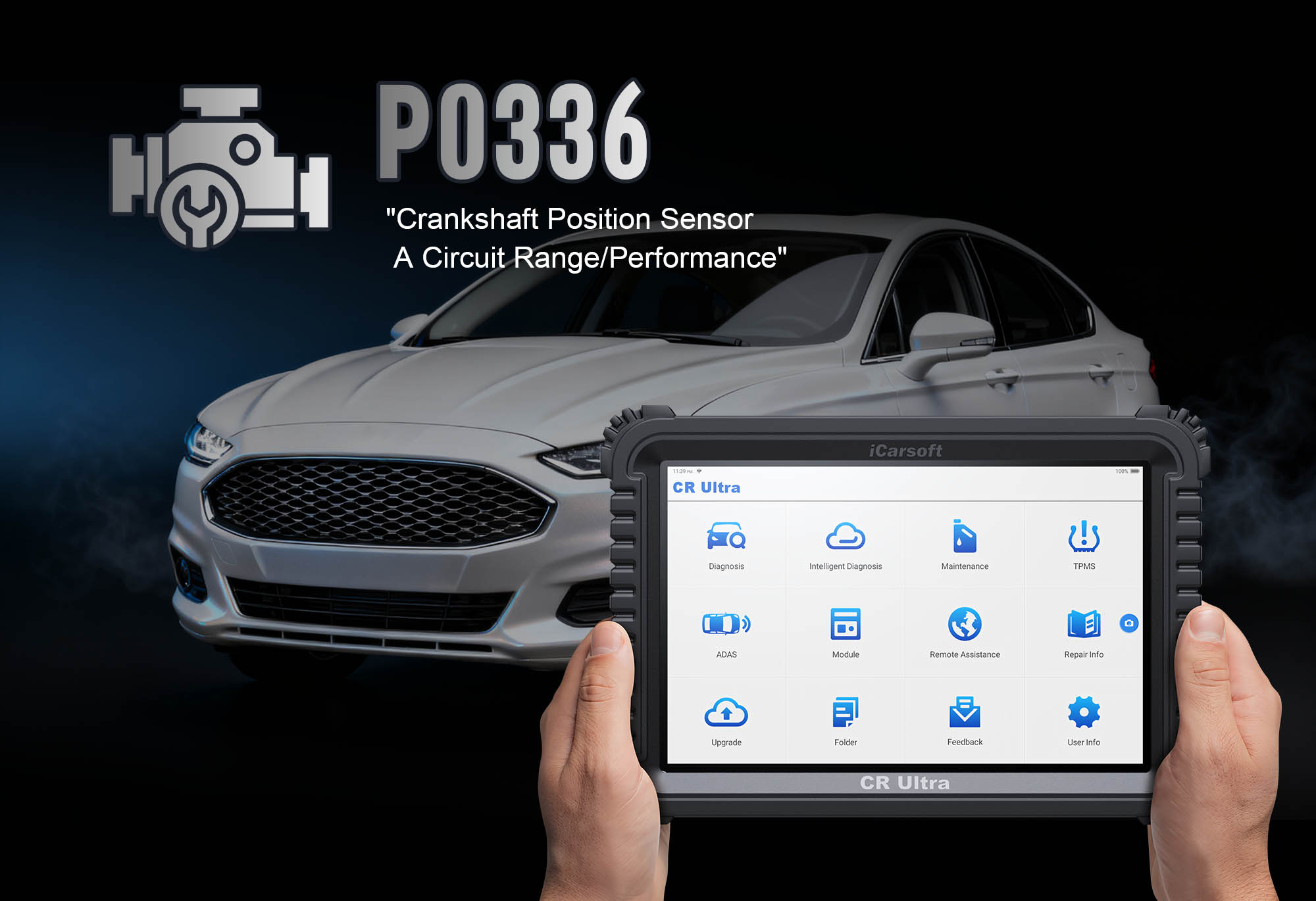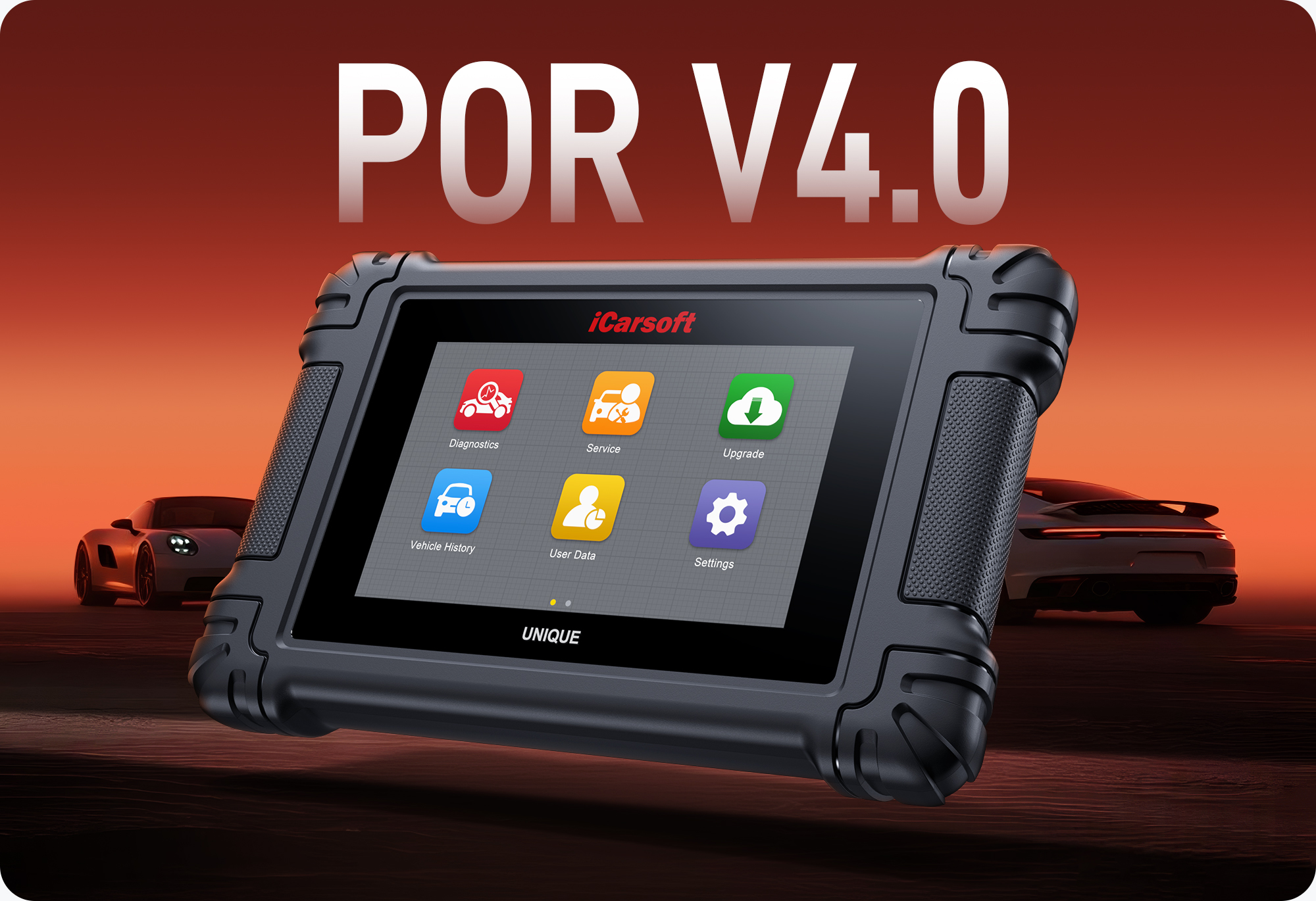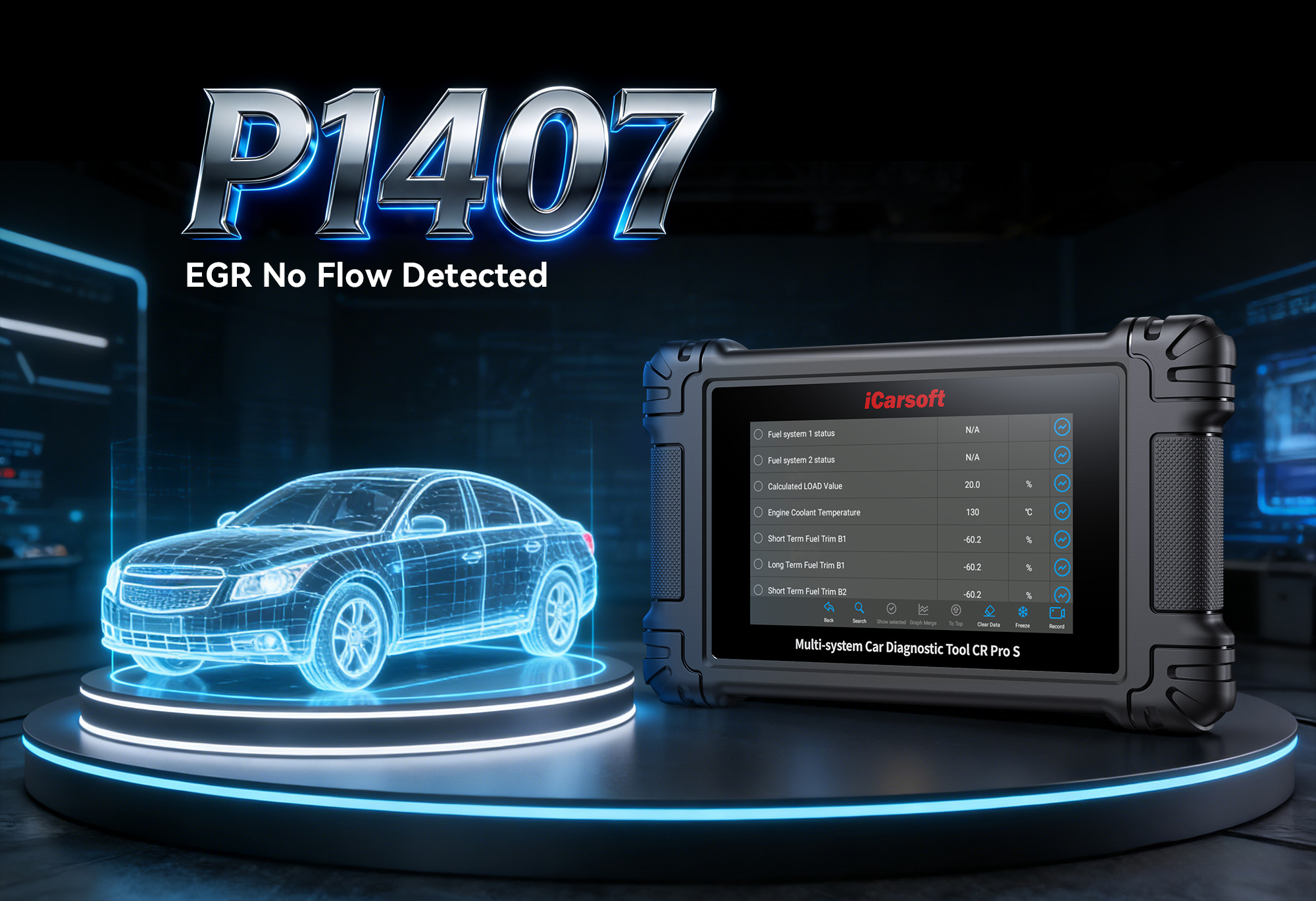Diagnose & Clear P0336 with iCarsoft CR Ultra: Fix Crankshaft Position Sensor A Circuit Range/Performance
If your check engine light illuminates and you experience hard starting, rough idle, or sudden stalling—especially at low speeds—a diagnostic scan will likely return P0336. This OBD-II code stands for "Crankshaft Position Sensor A Circuit Range/Performance," indicating the Engine Control Module (ECM) has detected irregular or unreliable signals from the crankshaft position sensor (CKP).
The crankshaft position sensor is a critical component in modern engines, monitoring the crankshaft’s rotation speed and position to synchronize fuel injection, ignition timing, and valve operation. A healthy CKP sensor sends consistent, high-quality signals to the ECM, ensuring precise timing for combustion. P0336 triggers when these signals are weak, intermittent, or outside the expected range—disrupting the engine’s ability to run smoothly. Left unaddressed, this can lead to misfires, reduced fuel efficiency, and even complete engine shutdown.
Basic scanners may only flag "crankshaft sensor fault" but can’t analyze signal quality or test sensor functionality. The iCarsoft CR Ultra—with its advanced CKP signal waveform analysis, live data tracking, and circuit integrity tests—solves this. Let’s explore how to diagnose and resolve P0336 using this professional-grade tool.
 iCarsoft CR Ultra: Analyzing CKP sensor waveform and signal quality to resolve P0336
iCarsoft CR Ultra: Analyzing CKP sensor waveform and signal quality to resolve P0336
Understanding P0336: Causes & Key Symptoms
A faulty crankshaft position sensor or its circuit creates distinct performance issues rooted in timing disruptions. Below are the critical symptoms to identify and common causes to target.
Key Symptoms of P0336
-
Check Engine Light: Illuminates when the ECM detects erratic CKP signals for 3+ drive cycles (varies by manufacturer).
-
Hard Starting: The ECM can’t determine the crankshaft’s position, making it difficult to time fuel injection and ignition correctly—extended cranking may be required.
-
Rough Idle or Misfires: Inconsistent timing leads to uneven combustion, causing the engine to shake or misfire at idle.
-
Stalling: Sudden loss of CKP signals (e.g., due to a loose connection) cuts off fuel and ignition, shutting down the engine—often at stops or low speeds.
-
Reduced Power: The ECM enters "limp mode" to protect the engine, limiting RPM and acceleration to prevent damage.
-
Increased Fuel Consumption: Incorrect timing forces the ECM to overcompensate with extra fuel, lowering MPG by 10–15%.
Common Causes of P0336
-
Faulty Crankshaft Position Sensor: A worn or damaged sensor (e.g., cracked housing, degraded magnet) produces weak or erratic signals.
-
Dirty Sensor or Reluctor Ring: Oil, debris, or metal shavings on the sensor tip block the magnetic field, distorting signals. The reluctor ring (toothed wheel on the crankshaft) may also be damaged or dirty.
-
Wiring or Connector Issues: Corroded terminals, frayed wires, or loose plugs in the CKP circuit create high resistance, weakening signals.
-
Sensor Alignment Problems: The CKP sensor must be positioned precisely relative to the reluctor ring. Misalignment (due to loose mounting bolts or engine movement) causes inconsistent readings.
-
ECM Malfunction: A faulty module may misinterpret valid CKP signals or fail to process them correctly (rare but critical to rule out).
Why iCarsoft CR Ultra Excels at Diagnosing P0336
The CR Ultra outperforms basic tools with specialized features for crankshaft position sensor diagnostics—ensuring you don’t just "replace the sensor" but fix the actual cause of signal irregularities.
CKP Signal Waveform Analysis
Captures and displays real-time voltage patterns from the CKP sensor, identifying irregularities like "dropped signals," "noise," or "weak amplitude." Visualizes issues basic scanners can’t detect (e.g., "Missing 2/10 reluctor tooth signals = dirty sensor").
Live Data Tracking
Monitors crankshaft position, RPM, and signal frequency simultaneously. Highlights discrepancies (e.g., "RPM = 800, CKP Frequency = Erratic") to distinguish sensor faults from wiring issues.
Circuit Resistance Testing
Measures resistance in the CKP sensor circuit (wiring, connectors) to detect high-resistance issues. Normal range = 500–1,500 ohms (varies by sensor); infinite resistance = broken wire, 0 ohms = short.
3D Component Mapping
Shows high-resolution diagrams of the CKP sensor location, reluctor ring, and wiring path for 200+ vehicle brands (e.g., "Honda Civic: CKP Sensor = Behind Crankshaft Pulley"). Avoids guesswork during physical inspection.
Sensor Validation Tests
Sends test signals to verify the sensor’s ability to respond to reluctor ring movement. Distinguishes between sensor faults (no response) and alignment issues (inconsistent response).
ECM Communication Checks
Verifies the ECM is receiving and processing CKP signals correctly. Rules out module malfunctions (e.g., "ECM receives valid signal but logs P0336 = software glitch—update required").
Step-by-Step: Diagnose P0336 with iCarsoft CR Ultra
-
Connect & Confirm the Code
Plug the CR Ultra into your vehicle’s OBD-II port (use included adaptors for older models with non-standard ports). Power on the tool and select your vehicle via Auto VIN Scan (instant VIN reading) or manual entry (make/model/year/engine).
Navigate to Engine > Fault Codes > Read Codes to confirm P0336. Tap Code Details for vehicle-specific insights (e.g., "Toyota Camry: CKP Sensor Signal Intermittent; Check Sensor Connector & Reluctor Ring").
-
Locate the Crankshaft Position Sensor & Related Components
Use the CR Ultra’s 3D mapping to avoid unnecessary disassembly (critical for hard-to-reach sensors):
-
Go to Component Location > Engine > Sensors > Crankshaft Position Sensor.
-
The tool displays a 3D diagram highlighting:
-
CKP Sensor: Typically mounted near the crankshaft pulley (front), flywheel (rear), or oil pan—location varies by engine (e.g., inline-4s = front, V6s = rear near transmission).
-
Reluctor Ring: Toothed wheel attached to the crankshaft (the sensor reads its rotation—marked in yellow for visibility).
-
Wiring Harness: Path from the sensor to the ECM—marked in red, with notes on areas prone to damage (e.g., near timing belts or pulleys).
-
Mounting Bolts: Secure the sensor—loose bolts cause misalignment (marked with torque specs: typically 8–12 ft-lbs).
-
Analyze Live CKP Signal Data
Real-time data reveals the nature of the signal irregularity—start with this to narrow down causes:
-
Start the engine (if possible—if stalling occurs, have a helper hold the engine at 1,000 RPM during testing).
-
In the CR Ultra, go to Engine > Live Data > Crankshaft Sensor and monitor three key parameters:
-
CKP Signal Voltage: Normal = 0.5–1.0V AC (fluctuates with crankshaft rotation). Erratic voltage (<0.3V or >1.2V) = signal loss; flatline = no sensor output.
-
RPM Consistency: RPM should match CKP signal frequency (e.g., 800 RPM = steady 40 Hz signal). Fluctuating RPM with stable throttle = unreliable CKP data.
-
Signal Quality: The tool rates integrity as "Good," "Weak," or "Noisy." "Weak" = low sensor output; "Noisy" = electromagnetic interference or loose connections.
-
Test CKP Sensor Signal Waveform
A healthy waveform is the gold standard for CKP sensor functionality—use the CR Ultra to verify:
-
Waveform Capture: Navigate to Special Functions > Engine > Sensor Tests > CKP Waveform Analysis. The tool displays a graph of voltage over time (x-axis = time, y-axis = voltage).
-
Healthy Waveform Benchmarks: Consistent peaks and valleys (one peak per reluctor tooth), no dropped signals, and amplitude between 0.5–1.0V.
-
Abnormality Diagnosis:
-
Dropped Peaks: Missing 1+ peaks = dirty sensor tip or damaged reluctor ring tooth.
-
Low Amplitude: Peaks <0.4V = failing sensor or high circuit resistance.
-
Noise Spikes: Random voltage fluctuations = loose connector or electromagnetic interference (e.g., from a faulty alternator).
-
Inspect the Sensor, Reluctor Ring & Wiring
Physical faults cause ~80% of P0336 cases—inspect with guidance from the CR Ultra:
-
Sensor Inspection:
-
Locate the CKP sensor using the tool’s 3D map. Disconnect the wiring connector and remove the sensor (follow the CR Ultra’s Torque Guide for mounting bolt specs—over-tightening damages the sensor).
-
Check for:
-
Oil, dirt, or metal shavings on the sensor tip (clean with brake cleaner—avoid harsh solvents like acetone).
-
Cracks in the sensor housing or degraded magnet (magnet should attract a paperclip; weak attraction = replace sensor).
-
Reluctor Ring Check: Use a flashlight to inspect the ring (may require removing the crankshaft pulley on some engines). Look for missing teeth, cracks, or debris buildup. Damage = replace the ring (consult a mechanic for engines where the ring is integrated with the crankshaft).
-
Wiring & Connector Test:
-
Use the CR Ultra’s Multimeter Function to measure resistance:
-
Between the sensor’s signal pin and ECM pin: Normal = 500–1,500 ohms (check manufacturer specs). Infinite resistance = broken wire; 0 ohms = short to ground.
-
Between each pin and ground: Should be infinite (no continuity). Continuity = short to ground (repair wiring).
-
Inspect the connector for corroded terminals (white/green deposits) or bent pins. Clean terminals with electrical contact cleaner or replace the connector if damaged.
-
Verify Sensor Alignment & ECM Function
Misalignment or ECM issues often mimic sensor faults—rule them out:
-
Alignment Check:
-
Reinstall the CKP sensor (if removed) and torque mounting bolts to specs (per the CR Ultra’s guide).
-
Measure the gap between the sensor tip and reluctor ring (use a feeler gauge). Normal = 0.02–0.04 inches (0.5–1 mm). Adjust by adding/removing shims (if provided) or loosening/tightening bolts (on adjustable mounts).
-
ECM Signal Validation: Navigate to Diagnosis > Engine > ECM/PCM > CKP Signal Processing. The tool checks if the ECM is receiving and interpreting signals correctly:
-
"Signal Received & Processed Normally" = ECM is healthy.
-
"Signal Received but Misinterpreted" = ECM software glitch (update firmware via the CR Ultra’s Update Manager).
-
"No Signal Received" = wiring/sensor fault (recheck previous steps).
-
Repair & Clear P0336
Fix the root cause based on diagnostic findings (prioritize low-cost fixes first):
-
Replace the CKP sensor with an OEM part (use the CR Ultra’s Part Lookup for vehicle-specific compatibility—aftermarket sensors may have incorrect signal output).
-
Clean a dirty sensor tip or reluctor ring (use brake cleaner for the sensor, a soft brush for the ring).
-
Repair wiring faults: Replace damaged wires with heat-shrink connectors; splice only if necessary (use solder for reliability).
-
Adjust sensor alignment or replace loose mounting bolts (use thread locker to prevent future loosening).
-
Update ECM firmware if the Signal Processing test indicates a software issue.
-
Clear the Code: In the CR Ultra, go to Engine > Fault Codes > Clear Codes to delete P0336. Note: The ECM may require 2–3 drive cycles to confirm the fix.
-
Validate the Repair
Confirm the CKP sensor and circuit are functioning correctly to prevent recurrence:
-
Recheck live data—CKP signal voltage should fluctuate steadily (0.5–1.0V AC) and RPM should match signal frequency with no inconsistencies.
-
Retest the waveform—peaks and valleys should be consistent, with no dropped signals or noise.
-
Test drive for 30–40 minutes, including:
-
Cold start (turn off engine, wait 15 minutes, restart—no extended cranking).
-
Low-speed maneuvers (parking, stop-and-go traffic—no stalling).
-
Highway acceleration (60–70 mph—no limp mode or power loss).
-
Use the CR Ultra’s Quick Scan after the test drive—no P0336 recurrence = successful repair.
Preventing P0336 Recurrence
The CR Ultra helps maintain reliable CKP sensor performance long-term, reducing the risk of signal issues:
-
Sensor Maintenance: Set the tool’s Service Reminder to inspect the CKP sensor every 60,000 miles. Clean debris from the tip and check for housing cracks or magnet degradation.
-
Wiring Protection: Inspect the CKP harness quarterly for wear near moving parts (e.g., timing belts, pulleys). Use loom tape or split conduit to protect exposed wires from abrasion.
-
Oil Leak Checks: Address oil leaks promptly (use the CR Ultra’s Oil Leak Detection if supported). Oil contamination is the #1 cause of premature CKP sensor failure.
-
Regular Scans: Run the CR Ultra’s Quick Scan monthly to monitor CKP signal quality. Catch "pre-code" issues (e.g., "Signal amplitude dropping to 0.4V") before they trigger P0336.
Conclusion: Precision for CKP Sensor Reliability
P0336’s crankshaft position sensor issues are frustrating because they often present as "random" stalling or hard starting—but the iCarsoft CR Ultra turns guesswork into precision. By analyzing waveforms, testing circuits, and verifying alignment, this tool ensures you fix the actual cause (whether a dirty sensor, misalignment, or wiring fault) instead of wasting money on unnecessary sensor replacements.
For DIYers, this means confidence in diagnosing even intermittent signal issues. For professionals, it streamlines repairs and builds customer trust by resolving P0336 for good. With the CR Ultra, maintaining a healthy CKP sensor system ensures your engine’s timing stays synchronized—delivering smooth starts, consistent performance, and reliable operation for miles to come.

 iCarsoft CR Ultra: Analyzing CKP sensor waveform and signal quality to resolve P0336
iCarsoft CR Ultra: Analyzing CKP sensor waveform and signal quality to resolve P0336



